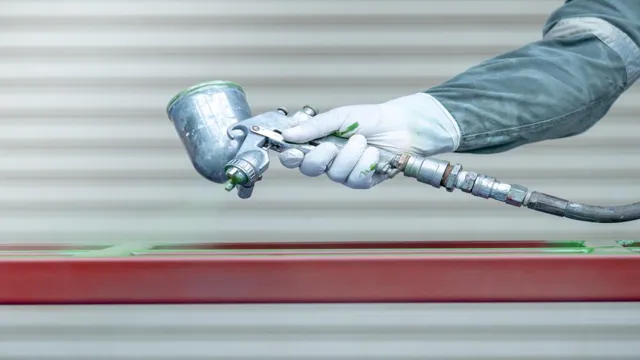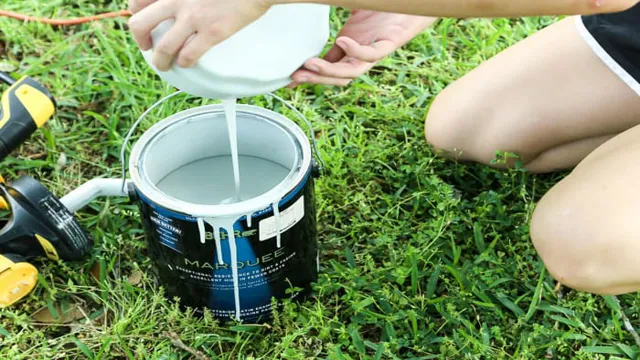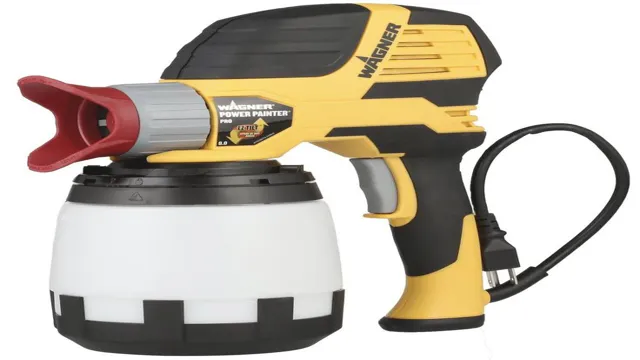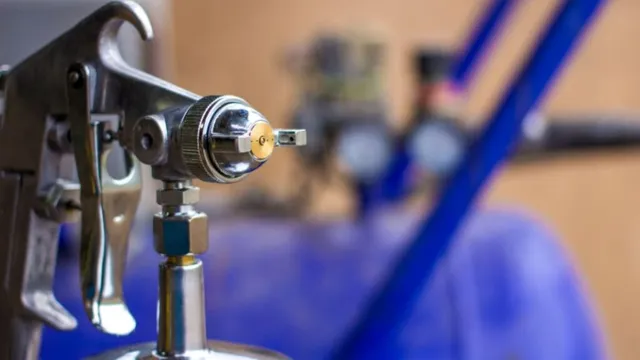Can You Put Any Paint in a Paint Sprayer? Tips on Choosing the Right Paint for Your Sprayer

If you’re planning to invest in a paint sprayer, you’re probably wondering which types of paint are compatible with it. After all, you don’t want to purchase a tool that can only be used with a limited range of paint products. So, can any paint be put in a paint sprayer? The short answer is no, not every type of paint is suitable for a sprayer.
However, different types of paint can be used with paint sprayers depending on their thickness, viscosity, and composition. In this blog post, we’ll go over the types of paint that you can use with a paint sprayer and the ones you should avoid. With this information, you can make an informed decision and get the most out of your paint sprayer.
So, let’s dive in!
Understanding Paint Sprayers
If you’re thinking of using a paint sprayer for your next painting project, one of the first questions you may have is whether or not you can put any paint in it. The answer is not straightforward and depends on the type of paint sprayer you have. Airless paint sprayers, for example, can handle a wide variety of paints, including latex, enamels, oil-based paints, and stains, whereas HVLP sprayers are better suited for thinner materials like lacquers and water-based paints.
While some sprayers may require you to thin your paint before use, it’s always best to check the manufacturer’s instructions to ensure you’re using the right type of paint for your sprayer. Using the wrong type of paint in your sprayer can lead to clogging, poor finish quality, or even damage to your sprayer. So, the answer is yes, you can put any paint in a paint sprayer, but you should always read the instructions and use a paint that is compatible with your specific sprayer model.
Types of Paint Sprayers
Paint sprayers are versatile tools used for painting surfaces with speed, accuracy, and consistency. There are three main types of paint sprayers: airless, HVLP, and compressed air, each with its own set of advantages and disadvantages. Airless sprayers use a high-pressure pump to atomize the paint, making them suitable for covering large areas with thick coatings.
HVLP sprayers, on the other hand, use a low-pressure turbine to produce an even and fine mist, making them ideal for detailed and intricate work. Compressed air sprayers, as the name suggests, rely on compressed air to atomize the paint, offering greater precision and versatility. When choosing a paint sprayer, it is important to consider the type of project you will be working on, the type of paint you will be using, and your budget.
Overall, paint sprayers are an investment that can save you time, money, and effort in the long run, making them an essential tool for any DIY or professional painter.

How Paint Sprayers Work
If you’re new to DIY painting or looking for ways to save time and effort on your next project, understanding how paint sprayers work can help. Paint sprayers use a high pressure or airless mechanism to atomize paint particles into a fine spray, which is then applied evenly to a surface. This makes it possible to cover large areas quickly and accurately, without leaving visible brush marks or streaks.
With practice, you can adjust the spray settings to achieve different levels of coverage and texture, making it easy to create a professional-looking finish. Whether you’re painting walls, furniture, or outdoor surfaces, a paint sprayer can be a valuable tool for simplifying and improving your project. So why not try it out and see the results for yourself?
Selecting Paint for a Paint Sprayer
When it comes to selecting paint for a paint sprayer, it’s essential to choose the right type of paint. The short answer is no; you can’t use any paint in a paint sprayer. Some paints are too thick to use in a paint sprayer, while others may require thinning before spraying.
It’s best to read the label on the paint can or check with the manufacturer before using it in a paint sprayer. Water-based paints are generally easier to use in a paint sprayer, but solvent-based paints can also work well with the right preparation. Remember to wear protective equipment when using a paint sprayer and to clean the sprayer thoroughly after use to prevent clogs and damage.
With the right type of paint and proper preparation, you can achieve professional-looking results with a paint sprayer.
Types of Paints You Can Use
When it comes to using a paint sprayer, selecting the right paint is crucial. There are various types of paints available that can be used with a sprayer, including latex, oil-based, and acrylic. Latex paint is the most commonly used paint for a sprayer due to its ease of use, quick drying time, and ability to clean up with soap and water.
Oil-based paints provide a durable finish and are perfect for heavy-duty surfaces, such as metal or wood. Acrylic paint offers excellent adhesion and dries quickly but isn’t as durable as oil-based paint. It’s vital to choose the right type of paint for your sprayer as each type has its own unique properties.
Make sure to read the manufacturer’s instructions to ensure you’re using the appropriate paint and to prevent any potential problems, such as clogging or inadequate coverage. By selecting the right paint for your sprayer, you can achieve a flawless finish every time without any setbacks.
Matching Paint to the Sprayer
When it comes to selecting paint for a paint sprayer, it’s crucial to match the type of paint to the sprayer. Different types of sprayers work best with specific types of paint, and using the wrong type can result in clogs, uneven coatings, and overall poor results. For example, airless paint sprayers work best with thick, high-viscosity paints such as latex or enamel, while HVLP sprayers work best with thinner materials such as stains and lacquers.
It’s essential to consult the sprayer’s manual and the paint manufacturer’s recommendations before selecting a paint. By choosing the appropriate paint for your paint sprayer, you’ll enjoy smooth, even coverage and excellent results every time.
Thinners and Mixtures
When it comes to selecting paint for a paint sprayer, it’s essential to consider the type of thinner or mixture to use. Thinners are used to reduce the viscosity of paint, making it easier to spray and achieve a smooth finish. The most common type of thinner is mineral spirits, which is ideal for use with oil-based paints.
For water-based paints, you’ll need to use a water-based thinner. You can also mix different types of paint to achieve custom colors or textures. However, it’s essential to follow the manufacturer’s recommendations when mixing paint to avoid compromising its quality or durability.
When choosing a paint mixture, it’s also crucial to consider the material you’ll be spraying and the type of finish you want to achieve. By taking the time to select the right paint and thinner or mixture, you’ll ensure that your paint sprayer delivers a flawless finish every time.
Considerations When Using a Paint Sprayer
Can you put any paint in a paint sprayer? It’s a common question among DIYers and professional painters alike. The short answer is: no. Not all paints are suitable for use with a paint sprayer.
In general, sprayers work best with thinner paints, such as stains, lacquers, and enamels. Latex and oil-based paints can also be used, but they may need to be thinned first to ensure proper atomization. Before loading your sprayer with paint, it’s essential to read the manufacturer’s recommendations and adjust your equipment accordingly.
Some sprayers may require specific nozzle sizes or tip types for optimal performance with certain paints. Using the wrong paint in your sprayer can result in clogging or uneven coverage, so it’s always best to consult the instruction manual and test the compatibility of the paint before committing to a large-scale project. By understanding the nuances of paint sprayer use, you can get professional-looking results on your next home renovation or DIY project.
Safety Precautions
When using a paint sprayer, it’s important to take safety precautions to avoid any potential accidents or injuries. You should always wear protective gear, like goggles, a respirator, and gloves, to keep yourself safe from the spray and any fumes from the paint. Additionally, it’s critical to ensure that the sprayer is properly grounded to prevent electrical shocks.
Before use, make sure to carefully read the manufacturer’s instructions and fully understand how the equipment operates. Keep in mind that paint sprayers can be noisy, so it’s a good idea to wear earplugs to protect your hearing. By following these safety guidelines, you can minimize your risk while achieving a smooth and professional-looking finish.
Surface Preparation
When it comes to using a paint sprayer, surface preparation is crucial for achieving professional-looking results. Before using the sprayer, it’s important to clean and sand the surface to remove any debris or imperfections. This makes the surface smooth and helps the paint adhere better, resulting in a better finish.
Consider the type of paint you’ll be using and the surface you’ll be painting on to determine the appropriate cleaning and sanding techniques. The keyword “Surface Preparation” is the centerpiece of achieving a great finish with paint sprayers. A well-prepared surface not only improves the appearance but also increases the longevity and durability of the painted surface.
Remember, patience is key when working with a paint sprayer. Taking the time to properly prepare the surface before spraying will ultimately save you time and frustration in the long run.
Conclusion and Final Thoughts
In conclusion, while it may be tempting to put any old paint in a paint sprayer, it’s important to remember that different sprayers are designed for different types of paint. Using the wrong type of paint can clog your sprayer and leave you with a nasty mess. So, do your research and make sure you’re using the right paint for the job.
After all, a sprayer is only as good as the paint it’s spraying!”
FAQs
What type of paint is recommended for use in a paint sprayer?
Not all paints are suitable for spray application. It’s recommended to use high-quality paint that is designed specifically for spray application.
Can you use water-based paint in a paint sprayer?
Yes, water-based paint can be used in a paint sprayer. However, it’s important to optimize the spray settings for the specific type of paint being used.
How do you thin paint for use in a paint sprayer?
Paint should be thinned with the appropriate solvent or thinner recommended by the paint manufacturer. Follow the manufacturer’s instructions for proper thinning ratios.
Can you use oil-based paint in a paint sprayer?
Yes, oil-based paint can be used in a paint sprayer. However, it may require additional thinning and clean-up with solvents.
What are the advantages of using a paint sprayer over a roller or brush?
Paint sprayers can provide a smoother and more even finish, allow for faster application, and can reach tight or hard-to-reach areas more easily than rollers or brushes.
How do you clean a paint sprayer after use?
The paint sprayer should be cleaned thoroughly with the appropriate solvent or cleaner immediately after use, following the manufacturer’s instructions.
Can you use a paint sprayer for interior and exterior painting projects?
Yes, paint sprayers can be used for both interior and exterior painting projects, but it’s important to choose the right sprayer for the job and properly prepare the surface for painting.



